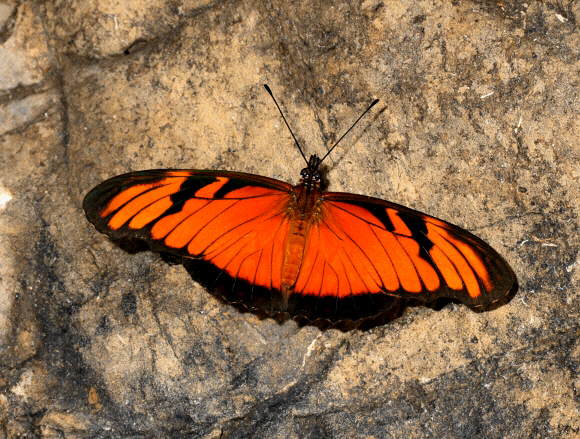 Dione juno, Satipo, Peru – Adrian Hoskins
Dione juno, Satipo, Peru – Adrian Hoskins
Introduction
The Heliconiinae was until a few years ago recently considered to be a full family equal in rank to the Nymphalidae, Satyridae, Papilionidae etc. In 1958 Erlich proposed that the families containing butterflies with only two pairs of legs should all be classified as subfamilies within the Nymphalidae. This proposition was again advanced by Ackery in 1984 and has since become accepted by most biologists. Thus we now have the Libytheinae, Satyrinae, Nymphalinae, Limenitidinae, Charaxinae, Apaturinae, Morphinae, Biblidinae, Ithomiinae, Danainae and Heliconiinae.
The higher classification of the Heliconiinae was revised by Penz & Peggie in 2003, being subdivided into the Acraeini, Argynnini and Heliconiini. The latter are colloquially known as Longwings and are characterised by their simple patterns, elongated forewings and delicate fluttering flight.
The Heliconiini includes the genus Heliconius ( 39 spp ), and the smaller genera Dryas, Dryadula, Eueides, Neruda, Laparus, Philaethria, Podotricha, Agraulis and Dione. The latter genus contains 3 species – glycera, juno and moneta – all with orange uppersides and silver-spangled undersides.
Dione juno is distributed from Mexico to Paraguay.
 Dione juno, Satipo, Peru – Adrian Hoskins
Dione juno, Satipo, Peru – Adrian Hoskins
Habitats
This species, like others in the genus, is migratory in behaviour, so can be found in many habitats, and at any altitude up to 2000 metres, but is commonest in disturbed forest between 200-800m. It is usually encountered in sunny areas by riverbanks, rocky slopes or roadsides.
Lifecycle
The eggs are bright yellow at first, later becoming red, and are laid in batches on the leaves and stems of Passiflora ( Passifloraceae ). The larvae are mottled in shades of light brown, with short bristly spines. They live gregariously and moult in synchronisation.
Adult behaviour
The male is usually encountered singly imbibing moisture from puddles or ditches. Females tend to be seen mainly when nectaring at Lantana and other shrubs.
